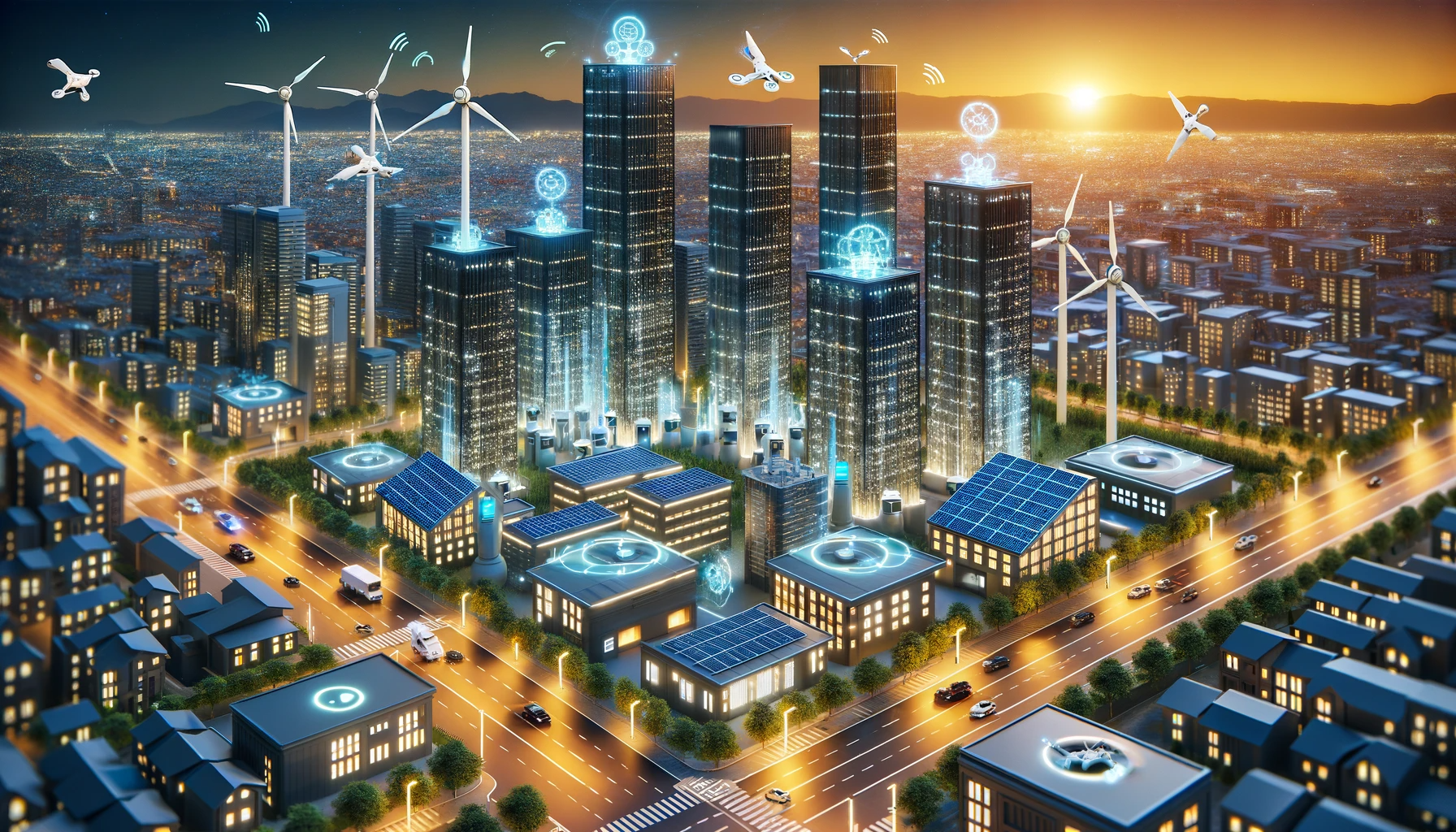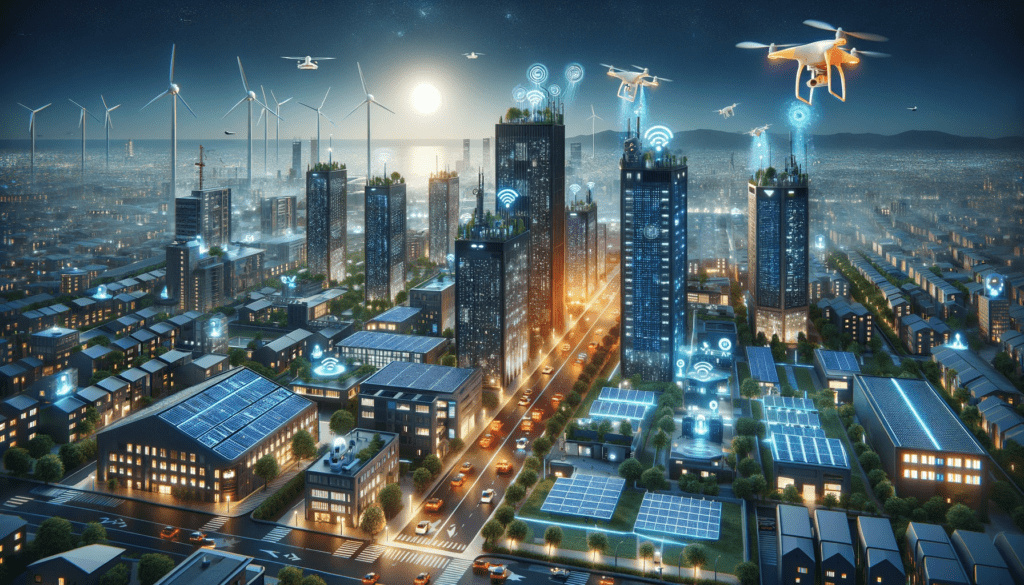The world is at a critical juncture, grappling with the pressing need to address environmental challenges and transition towards a sustainable future. At the heart of this transformation lies renewable energy, a vital component in reducing carbon emissions and mitigating the impacts of climate change. Renewable energy sources, such as solar, wind, and hydropower, have gained prominence as cleaner alternatives to fossil fuels, offering hope for a greener and more sustainable planet.
Efficient energy management is key to harnessing the full potential of renewable energy sources. It involves not only optimizing energy production but also ensuring that energy is distributed and consumed intelligently. The challenge lies in the intermittent nature of many renewables, such as sunlight and wind, which necessitates innovative solutions to balance supply and demand effectively.
Amid these challenges, a central question emerges: Can Artificial Intelligence (AI) play a pivotal role in managing and optimizing renewable energy sources? AI, with its ability to analyze vast datasets, make real-time decisions, and adapt to changing conditions, holds the promise of revolutionizing the energy landscape.
The purpose of this article is to delve into the transformative potential of AI in renewable energy management. We will explore how AI technologies can address the complexities of renewable energy, from forecasting energy production to optimizing storage and distribution. By examining real-world examples and discussing the challenges and ethical considerations, we aim to paint a comprehensive picture of AI’s role in ushering in a sustainable energy future.
The Renewable Energy Revolution
The global landscape of energy production is undergoing a profound transformation with the increasing adoption of renewable energy sources. Solar panels glisten on rooftops, wind turbines spin gracefully across horizons, and hydroelectric dams harness the power of flowing water. These technologies represent a shift away from traditional fossil fuels towards cleaner and more sustainable alternatives.
One of the primary drivers behind this renewable energy revolution is the urgent need to address environmental challenges, particularly the reduction of carbon emissions. The burning of fossil fuels has long been a major contributor to greenhouse gas emissions, leading to climate change and its devastating consequences. Renewable energy sources offer a ray of hope, as they produce electricity with minimal or zero carbon emissions.
The adoption of renewables is indeed on the rise, with an increasing number of countries and regions committing to ambitious renewable energy targets. These efforts have led to a significant impact on energy generation. Solar power, in particular, has seen remarkable growth, with photovoltaic panels becoming a common sight on rooftops worldwide. Similarly, wind energy has gained momentum, with vast wind farms providing clean electricity to communities.
The renewable energy revolution is not just a trend; it is a vital step towards a more sustainable future. However, it comes with its own set of challenges, particularly in terms of energy management and grid optimization.

The Challenges of Renewable Energy Management
While renewable energy sources offer immense promise, they come with inherent challenges that require innovative solutions. One of the most significant challenges is the intermittent nature of many renewables. Solar power generation depends on daylight hours, and wind energy production is influenced by wind speeds. These factors make it difficult to ensure a steady and reliable energy supply.
Efficient energy management is key to addressing these challenges. It involves not only optimizing energy production but also developing advanced storage and distribution systems. Energy storage is crucial to store excess energy generated during peak times and release it when demand is high but production is low.
Moreover, renewable energy grids need to adapt to changing conditions and be capable of handling variations in energy production. For instance, sudden cloud cover can reduce solar power output, and calm winds can halt wind turbines. Grids must balance supply and demand effectively to ensure a stable energy supply for consumers.
In this context, the role of Artificial Intelligence (AI) becomes increasingly relevant. AI technologies can provide real-time monitoring and decision-making capabilities that are essential for managing renewable energy grids efficiently. In the following sections, we will delve into how AI can address these challenges and potentially revolutionize renewable energy management.
AI in Energy Management
Artificial Intelligence (AI) is a branch of computer science that focuses on creating systems capable of performing tasks that typically require human intelligence. In the context of energy management, AI is a powerful tool that leverages advanced algorithms and data analytics to optimize the generation, distribution, and consumption of energy resources. Its relevance in the energy sector is paramount, as it addresses the complexities of managing renewable energy sources and modernizing the grid infrastructure.
AI’s applications in the energy sector are diverse and encompass various aspects of energy management:
- Grid Optimization: AI plays a crucial role in optimizing energy grids. It analyzes vast amounts of data in real-time to balance supply and demand efficiently. Grid optimization ensures that electricity is distributed where it is needed most, reducing energy wastage and improving overall grid reliability.
- Demand Forecasting: AI can predict energy demand patterns accurately. By analyzing historical data, weather conditions, and other relevant factors, AI models can forecast when and where energy demand will peak. This information helps grid operators plan for optimal energy production and distribution.
- Predictive Maintenance: AI-driven predictive maintenance helps prevent costly equipment breakdowns by identifying potential issues before they occur. By analyzing sensor data and performance trends, AI can schedule maintenance activities to maximize equipment uptime.
The advantages of using AI in energy management are substantial:
- Increased Efficiency: AI-driven systems can optimize energy production and consumption, reducing waste and inefficiencies. This leads to improved resource utilization and lower operational costs.
- Reduced Environmental Impact: AI can help integrate renewable energy sources seamlessly into the grid, reducing reliance on fossil fuels and decreasing carbon emissions.
- Enhanced Reliability: AI ensures that energy grids operate reliably, minimizing power outages and disruptions.
- Cost Savings: By optimizing energy usage and reducing maintenance costs, AI can lead to significant cost savings for energy providers and consumers.
In summary, AI is a critical component of modern energy management. Its ability to analyze vast amounts of data, forecast energy demand, and optimize grids makes it an indispensable tool in transitioning towards efficient and sustainable energy systems.
Optimizing Renewable Energy Sources
AI has the potential to revolutionize the use of renewable energy sources such as solar and wind by addressing their inherent variability. One of the primary challenges in renewable energy is the intermittent nature of these sources. For instance, solar power generation depends on sunlight, which varies throughout the day and is subject to weather conditions. Similarly, wind energy is influenced by wind speeds, which can fluctuate unpredictably.
AI can address these challenges through the following means:
- Energy Production Forecasting: AI can forecast the energy production of renewable sources with remarkable accuracy. By analyzing historical data, weather forecasts, and other relevant parameters, AI models can predict when and how much energy will be generated. This enables grid operators to plan for fluctuations in supply and demand effectively.
- Efficient Energy Storage: AI can optimize energy storage solutions, such as advanced batteries and smart grids. It can determine the most efficient times to store excess energy and release it when demand is high, reducing energy wastage and optimizing storage capacity.
- Real-time Balancing: AI can balance energy supply and demand in real-time. When renewable energy sources suddenly produce less power due to changes in weather conditions, AI can compensate by adjusting other energy sources or activating energy storage systems to maintain grid stability.
Several real-world examples illustrate the transformative impact of AI on renewable energy systems. For instance, AI-driven solar forecasting systems have significantly improved the efficiency of solar power plants by predicting cloud cover and adjusting energy production accordingly. In wind energy, AI-powered turbines can adjust blade angles and orientations in response to changing wind speeds, maximizing energy generation.
The integration of AI into renewable energy management not only increases the reliability of these sources but also accelerates the transition towards a sustainable and carbon-neutral energy landscape. AI’s ability to harness renewable energy efficiently is a crucial step in addressing global environmental challenges and reducing reliance on fossil fuels.
AI for Energy Storage
AI plays a crucial role in enhancing energy storage solutions, such as advanced batteries and smart grids, ensuring efficient and sustainable energy management.
Advanced Batteries: AI can optimize energy storage by monitoring and managing advanced batteries used in renewable energy systems. Machine learning algorithms analyze battery performance data to predict degradation and potential failures. By identifying issues early, AI enables maintenance teams to replace or repair batteries proactively, reducing downtime and maximizing storage capacity.
Smart Grids: AI is a driving force behind the development of smart grids. These intelligent grids incorporate sensors, data analytics, and automation to enhance energy distribution and reduce losses. AI algorithms continuously analyze data from smart meters, weather forecasts, and energy consumption patterns to balance supply and demand. This real-time optimization ensures that electricity is distributed efficiently, reducing transmission losses and improving overall grid stability.
Real-world Applications: Real-world applications of AI in energy storage are becoming increasingly prevalent. For example, Tesla’s Powerpack, an energy storage solution, utilizes AI algorithms to manage energy flows in commercial and industrial settings. These algorithms optimize when and how energy is stored and discharged, contributing to significant energy savings and cost reductions for businesses.
The Role of AI in Policy and Regulation
AI plays a pivotal role in assisting governments and regulatory bodies in formulating policies for sustainable energy management. The integration of AI-driven regulations is essential to encourage the widespread adoption of renewable energy sources and foster a transition towards a more sustainable energy landscape.
Energy Policy Formulation: AI can analyze vast amounts of data related to energy consumption, generation, and environmental impact. This data-driven approach enables policymakers to make informed decisions about energy policies. AI can forecast the impact of different policy scenarios, helping governments design strategies that promote renewable energy adoption and reduce greenhouse gas emissions.
Incentive Programs: AI can be used to design incentive programs that encourage individuals and businesses to adopt renewable energy solutions. By analyzing economic data and energy consumption patterns, AI can identify areas where financial incentives or tax breaks would have the most significant impact on renewable energy adoption.
International Collaboration: AI can facilitate international collaboration in addressing global energy challenges. Through data sharing and analysis, countries can learn from each other’s experiences and develop coordinated strategies for renewable energy adoption and sustainability.
Several regions and countries have successfully integrated AI into energy policy. For example, Denmark has leveraged AI to optimize its wind energy production, making it a world leader in wind power. Similarly, Germany has implemented AI-driven energy efficiency programs to reduce energy consumption in buildings.
Challenges and Ethical Considerations
Despite the tremendous potential of AI in renewable energy management, there are several challenges and ethical considerations that need to be addressed:
Cost: The initial investment in AI infrastructure can be significant, posing a barrier for smaller organizations and regions with limited resources. Governments and institutions must consider ways to make AI technology accessible and affordable for all.
Data Privacy: AI relies on vast amounts of data, including personal and sensitive information. Ensuring data privacy and protection is crucial to building public trust in AI-driven energy management systems. Stricter regulations and robust security measures are necessary to address this concern.
Algorithmic Bias: AI algorithms may inadvertently introduce biases into energy management decisions. These biases can impact resource allocation and energy distribution. It is essential to develop algorithms that are fair and unbiased, taking into account diverse communities and regions.
Transparency and Accountability: Transparency in AI decision-making processes is essential for stakeholders to understand how energy management decisions are reached. Clear accountability measures should be in place to address any issues or errors that may arise from AI-driven systems.
Addressing these challenges and ethical considerations is vital to realizing the full potential of AI in renewable energy management. As AI continues to play a central role in shaping the future of sustainable energy, responsible and ethical practices must guide its development and implementation.
The Future of Renewable Energy with AI
The future of renewable energy appears increasingly promising as AI continues to advance. AI technologies are poised to further revolutionize energy management, contributing to a more sustainable and efficient energy landscape.
Emerging AI Trends: One of the emerging trends in AI for renewable energy is the integration of quantum computing. Quantum computing has the potential to solve complex energy optimization problems much faster than traditional computers, leading to more efficient energy grids and improved renewable energy integration. Additionally, the development of AI-driven swarm intelligence, inspired by natural systems like bees, can enhance the coordination and optimization of renewable energy resources.
AI and Decentralized Energy: AI is expected to play a pivotal role in the rise of decentralized energy systems. These systems, characterized by distributed energy generation and storage, can benefit from AI’s real-time decision-making capabilities. As more individuals and communities adopt solar panels, wind turbines, and energy storage solutions, AI can help manage these distributed resources efficiently.
Accelerating Sustainability: AI’s ability to analyze vast amounts of data in real-time will accelerate the transition to a sustainable and renewable energy future. AI-driven predictions and insights will enable better resource allocation, grid management, and demand forecasting. This, in turn, will reduce greenhouse gas emissions and increase the overall efficiency of energy systems.

Conclusion
In conclusion, AI holds immense potential in revolutionizing renewable energy management, offering solutions to some of the most pressing challenges in the transition to a sustainable future. As we witness the global shift towards renewable energy sources, the integration of AI-driven technologies is becoming increasingly crucial.
From optimizing energy grids to enhancing energy storage solutions and formulating data-driven policies, AI can play a pivotal role in achieving greater efficiency, reducing waste, and maximizing the use of renewable energy resources. However, to fully harness the benefits of AI in renewable energy, we must address challenges related to cost, data privacy, algorithmic bias, and transparency.
The future of renewable energy with AI is bright, with emerging trends and technologies on the horizon. Quantum computing, swarm intelligence, and decentralized energy systems are just a glimpse of what’s to come. By embracing AI responsibly and ethically, we can accelerate the transition to a sustainable and efficient energy landscape, mitigating the impacts of climate change and ensuring a brighter future for generations to come.
